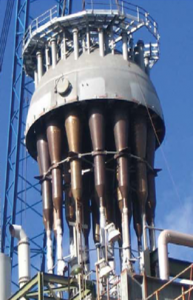Concerns about changes in refinery FCC unit heat balances have surfaced more frequently as refiners increase resid content, which increases delta coke. In turn, this increase reactor temperature while reducing catalyst-to-oil ratio. Other unit operating factors have been receiving closer scrutiny in order to better optimize unit operations. Some of these factors include monitoring the various sources of coke, such as catalytic coke, requiring more careful scrutiny of the cyclone separators and diplegs, along with riser termination devices (RTDs) into the reactor.
Mechanical enablers available to improve the unit heat balance and overall operational efficiency include feed nozzle improvements, torch oil nozzles, RTDs, and connected rotating equipment that need to be considered for optimizing performance of resid FCC units and high olefins FCC units.
This goes without saying that process objectives have put into question the current mechanical versatility of many existing FCC units. The substantial mechanical infrastructure involved in FCC operations focuses on the FCC reactor, regenerator, gas concentration unit and linked main air blowers.
In one of the several FCC sessions on May 2 at the RefComm Galveston refining conference, independent consultant, Chris Dean concentrated a substantial amount of time solely on the unit’s cyclone separators and connected RTDs. While a detailed discussion on RTDs is beyond the scope of this discussion, changes in feedstocks and product objectives being what they are, such as towards more olefins, we may see more suppliers providing more options to improving circulation in the FCC with these assets.








Leave a Reply
You must be logged in to post a comment.